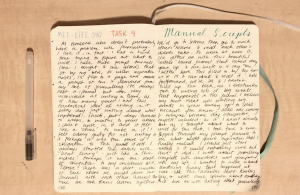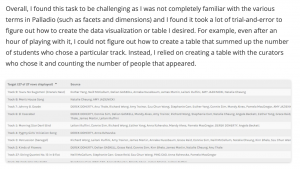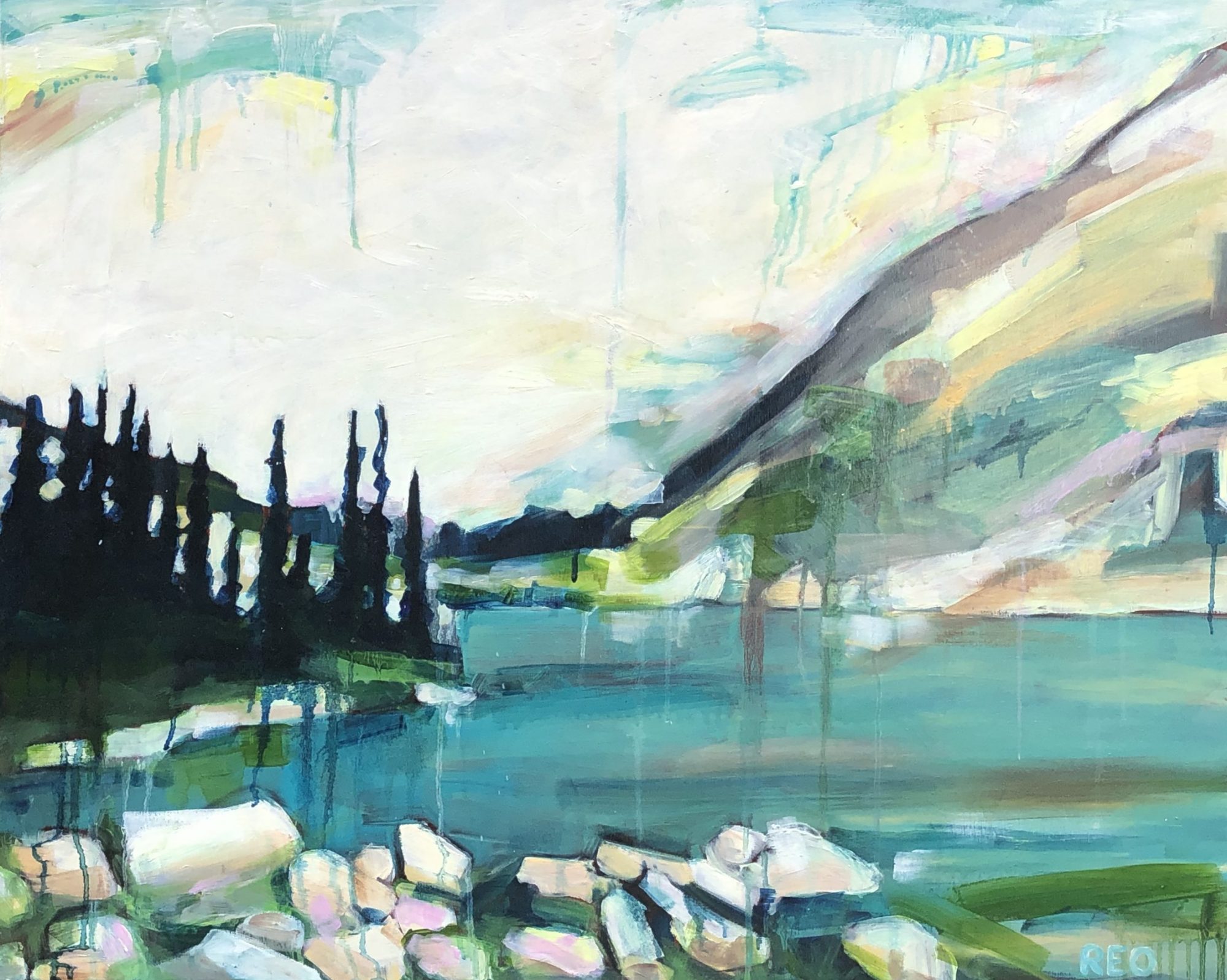LINK #1
Clarissa and I worked together in a previous course, so I was immediately drawn to her webspace. I loved that she went a different direction on Task #4, and quickly became engrossed in her reflection upon her journalling. I also have included this beautiful photo that she took of her writing as it grabbed my attention immediately. I have a great visual memory and am terrible with names, so I also find that associating imagery with conversations or data always helps me to better store and retrieve data.

This is Clarissa’s photo of her writing and below is an excerpt from her reflection that I focused on:
“I feel time and stamina is the significant difference. I was very aware how quickly my hand started to feel sore from writing. Although, I also I tend to write swiftly and press hard. I think other forms of manual writing, such as calligraphy, contribute to this idea of time and stamina being a factor. However, even if a mechanized form of writing, such as typing, is meant to speed up the process, I think it depends on the person engaging with it. In comparison to my parents; I prefer typing over writing by hand for some tasks, while my mother would almost always prefer writing by hand, then typing it only out of necessity – clarity, work, etc.”
Here is my response (connection) that I responded to her with.
Clarissa! It is so nice to have another class with you.
Your hand writing is beautiful and I love that you have spoken here about the soreness of your hand and the pressure of writing. I am connecting this with how my students feel about a large ink project like a Zentangle verses a detailed drawing project with a lot of pencil shading. I think that the instrument we use, how we hold it and the gestures that we make repetitively must be much of the issue. In sketching and drawing in graphite, my students never complain about hand cramping or soreness. However, with rollerball ink pens, they always do after about a half hour. We end up giving our hands a break, a stretch and a light massage.
On this note, I think about mom who worked as a typesetter for a newspaper, and then as a secretary and a library technician. With the advent of the computer, she suffered in later years from tendonitis in her wrists. She wore braces and even bought a special keyboard to help. I notice now that I wake up with stiff fingers after working late at night on papers for UBC, but that staying up all night painting in my studio only affects my shoulder and not my fingers.
I wonder, especially with voice to text softwares increasing in popularity, how the future of “writing” will change to better accommodate or physical needs and limitations?
_______________________________________________________________
LINK #2

Above is a screen shot I captured from Richard Wong’s site.
When I came upon this image on Richard Wong’s site, I paused and reread about his experiences. I found that we were like minded in the data we wanted to see, we struggled to find what we wanted and settled on using the same type of data pull and manual counting to get what we wanted. It was frustrating exercise for me initially and I had chalked it up to my not being familiar with analytics and the program.
I found it helpful to see some similarities between our work and it provided a much-needed confidence boost for me. Here is what I posted back to Richard:
_______________________________________________________________
LINK #3
To date, this was the most influential of task posting done by another student that I have encountered. I have not yet seen a mark for my Task #9, and am now worried that I have failed miserably at digging deep into analyzing the importance of the data that was not collectable in any meaningful way. I clearly got caught up in manipulating the data, organizing it be visually appealing and too easily dismissed the blaring absence of anything truly personal or meaningful of what can actually be accurately conveyed by such a program.
Grace caught my eye with a catchy title and then used a children’s book to illustrate her point about the importance of perspective in analysis. After reading through her posting, I was compelled to return to my own posting and am glad that I at least have this opportunity (here) to acknowledge the shallowness of my work last week. This is what I wrote to her and I am planning skip the last optional task so that I might better delve into #12 and my final project.
Grace,
I was first drawn to your post by the use of a children’s book to introduce your theme. You’ve beautifully illustrated how much of what we glean from any data set is dependent upon our own perspectives.
I spent much my task time last week arranging the data from my class in ways that helped me to visually understand trends and connections. I was quite interested in the WHY my peers selected or didn’t select songs, lamented that the most personal part of the choosing wasn’t available in the visuals, but then moved away from what was missing to reflect upon social media the implications of “social influencers”.
I felt that I needed to respond to your post, as I look back now to last week and I see the work you did in questioning all that was missing, importing your own data and then evaluating the tool (Palladio). I am impressed, humbled and inspired by your inquiry process. You ended your post with some lovely questions and a VERY quotable summary.
I mostly want to say thank you. This is a very timely reminder for me that I can dig deeper, question more and be remarkable.
THANK YOU!
ps…
I sincerely hope that you received top marks for Task #9!
pps…
here is a link to my data sort images ;-$
Quote I loved at the end of her post:
“Palladio is a valuable tool to help one start asking bigger questions. It’s a captivating opening paragraph to a really great story with many different interpretations.”
-Grace Reid, 2021
_______________________________________________________________
LINK #4
For Task #7, I was very inspired by Lexie’s video. It was not the content, but the way that she used a platform that I have been shying away from. To date, each time I have clicked on the app or inadvertently linked there, I have lost huge amounts of time and felt that the return was minimal or even so much of a blur as to be insignificant. I find it visually OVERSTIMULATING and I struggle with the way one video leads to another.
on the other hand, this is exactly why I am constantly trying to up my game and feel like I am competing with phones in my class. So…
https://www.youtube.com/watch?v=vHT8obnWmoc&list=PLqrIPvuDs5L-S42mp5ujeGOUcD77SejaH&t=4s
Hi Lexie!
I enjoyed the way you knit together your TikTok videos and incorporated the text and speech. I also found the pronunciations amusing and it added to my likability of the multimedia.
I am actually connecting with you on this as I am wondering about this as a medium for students to talk about their art works? Have you any experience here?
I have been using the Scholantis portal for the past six or seven years. Their portfolio builds up year-to-year, it is a great way to connect images of art and textiles projects to parents and the amazing comments follow the images/videos. As of February, I will no longer have this platform. We will only have TEAMS, and I need some better ways to engage my grade 8-12 students. I’m not sure that TikTok could replace the parental connection, but I’m feeling lost in a sea of choices.
You have inspired me to try creating a TikTok, but I am nervous about it. My homework for tomorrow will be to watch some how videos with art topics and see what is possible. Until I saw your mashup, I hadn’t thought of this as an option. Thank you, I think!
_______________________________________________________________
LINK #5
Today I cam across Emily Chen’s posting for task #10. I really enjoyed Tristan Harris’ TED Talk and I connected with her use of this as a springboard for her thoughts on social media and her worries about her daughter. Emily lives in Taiwan, but we otherwise have a lot in common. My daughter loves commercials and I, too, have become hyper aware of my time on social media and I compare it to my partner’s use.
I remember back MANY years ago when he and I started dating. We were living in different cities at the time and one evening he called me – on the phone. Now, to back up a bit, as a teenager I talked on the phone A LOT. It was the 90’s. However, that evening he settled into what was looking to be a lengthy chat and I had to level with him. (I was in my early 30’s and I no longer used the telephone for extended conversations. I had a ton of prep work to do that night for my classes the following day, and I really only called friends on the phone so that I could make plans to connect with them in person).
Sometime within the past decade I had decided that being with someone was so much richer. I would save up my free time (on purpose!), just get everything done so that I could have blocks of time with people that I cared about.
So, my conversation with Scott went like this…”I’m not really a phone talker.” He replied with something like, “huh?” And I think I just persisted along that line. I didn’t explain why, other than that I had work to do, and eventually he adjusted to it. He sees now that I am a social person. I spend my energy with people. I love to cook. I love to cook for others.
This is what Emily wrote that made me stop and reread it twice more:
“The TEDtalk By Tristan Harris in 2017 was very enlightening for me. I think he raised a very interesting and critical behaviour change that social media companies like Facebook should make, which is the idea of “find and replace” (Harris, 2017). This idea brings us to find all the timelines that are steering us towards having more screen time, and replace them with what we want in our lives. It makes me reflect on my time browsing through my friend’s Facebook when I could have just scheduled a video call with her. My motivation for spending 20 minutes on her Facebook Wall was because I missed her and wanted to know more about what was happening in her life, but that didn’t help connect us or bring us closer together. I am now more aware when I am on the internet of the strategies that companies are using to keep me online for a longer period of time. “
I realize that since the pandemic started, I have been spending more and more time on my friends’ walls and not enough time cooking for them. I feel sad, overwhelmed – very overwhelmed – and a bit inspired. My six year old is scheduled for a vaccine in a week and I need to start getting out of my social media shell.
New goal : I’ve always wanted to master polenta from scratch (I used to pick a dish every summer-pre Master’s. The buttercream frosting summer was my all time favourite – but my mom swears that the creamy mushroom risotto was my best accomplishment). This weekend will be a foray into a culinary challenge and I will invite company…and I will phone them to inquire!
ps. If I could connect with everyone this way, I would delete Facebook!
_______________________________________________________________
LINK #6
For his final assignment, Anton Didak created this YouTube video. As an artist I was immediately drawn to it and loved that I had new insight into an enigmatic art practice. I also am pleased that I kept going and watched another video on the subject and will have more to follow. I wonder if there is a way to translate my paintings to NFT’s? That is next on my research list!
My written response to Anton…
Thank you, Anton!
I am still a bit confused and not sure about how the buying and selling of NFT’s really works, but I see that there there are other videos on YouTube that might help me with that part. I am an artist, but not a digital artist. I am also an Art teacher, so I this is a topic I feel that I need to invest some time in and I appreciate that it was a complex project for you to present on.
You did a great job of linking with Hargreave and I think that I best like the idea of comparing NFT’s to baseball cards. The paper itself doesn’t have much value, but it can be valued because it is rare or one of a kind.
As an art teacher, I now am wondering where this might fit into my curriculum. Perhaps there is a way that we can create them and trade them like Artist Trading Cards, without huge fees for the online transactions? I’m interested in your thoughts on this. Also wondering if you have used NFT’s in a classroom?
